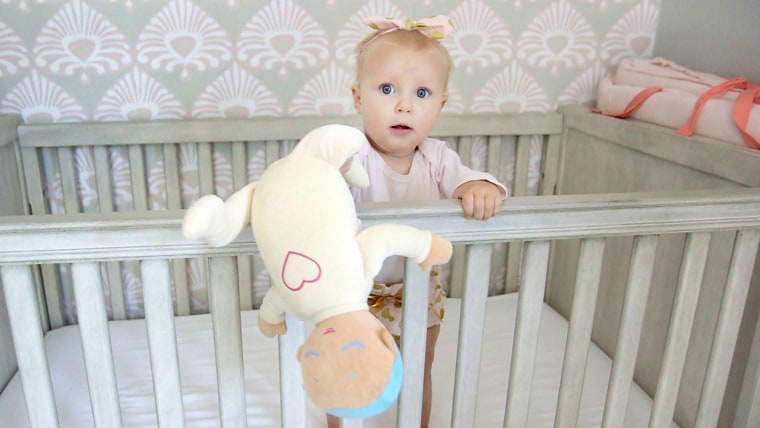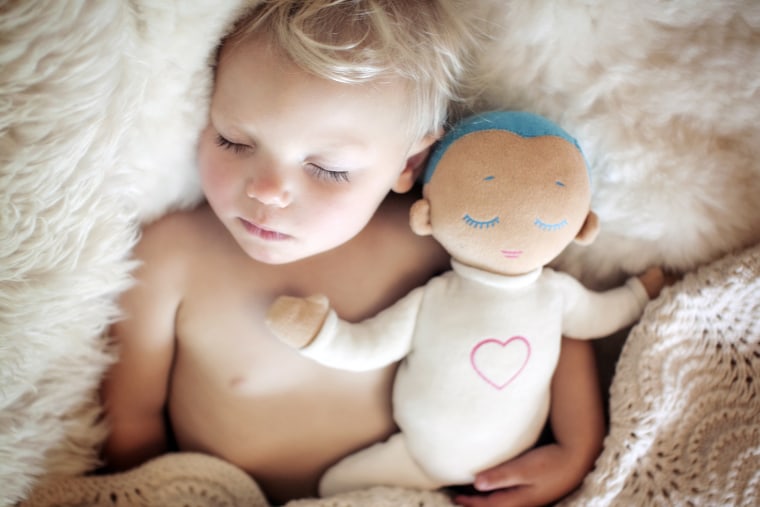For the first five months of my son’s life, I was obsessed with sleep. Or, more specifically, my lack thereof.
I spent many middle-of-the-night hours by the light of my iPhone, Googling all possible variations of that elusive phrase: “How to get a baby to sleep.”
I crossed off countless afternoons as we tried to get on a “nap schedule,” staring anxiously at the clock so I could run into his room and soothe him in five-, 10- and 15-minute increments.
I swaddled.
I super-swaddled.
I straightjacket-swaddled.
I bought magic sleep suits and sleep sacks and loveys and binkies. I stress-ate my way through piles of sleep books, leaving chocolate evidence on dog-eared pages.
So when I scrolled past a story one sleepless night in my Facebook feed about a doll that claimed to help babies sleep better, I clicked.

“Ridiculously high bids for ‘sleep doll’ prove how damn desperate parents are for sleep,” the headline screamed. “This doll might make your infant sleep, but it might come at a cost.”
Turns out sleep-deprived parents around the globe had heard about this magical product, the Lulla doll, and bought them all. The website sold out so fast (twice) that parents rushed to eBay to snatch them up at crazy mark-ups — reportedly paying as much as $665 for the doll that normally costs $71.
WATCH: Test-driving the Lulla sleep doll
Look, I get it. Catch me at the right bleary-eyed moment and I too might have been willing to pay anything for a few more zzzzzs. But was this really the magic bullet? I had to know.
So I wrote to Iceland (where the doll was invented), and the next thing I knew, the Lulla doll was on its way to me from Rejkyavik, via its incredibly kind and soothing-voiced creator, Eyrún Eggertsdóttir. (If you want to feel relaxed, just listen to her explain the process behind the doll in this video.)
When my Lulla doll arrived, it was much smaller (and cuter) than I'd imagined. It's soft and plush with cartoony closed eyes, and a little voice box sewn in the back, that — when squeezed — plays a recording of a woman's heartbeat and breathing sounds for up to eight hours.
I'm not the first person to compare it to Darth Vader. If you hear the noises coming from a darkened room, it can be a little terrifying.

The doll's heartbeat and breathing noises are supposed to mimic a caregiver's, to soothe a baby when a caregiver is not able to be there. "My goal was to make a product for babies that imitated closeness when their parents had to be away," Eggertsdóttir told TODAY. "Research tells us that closeness helps babies regulate their own heartbeat and breathing and this in turn results in better quality sleep, more overall wellbeing as well as added safety."
She and her team, who have worked for three years to make the doll a reality, solicited lots of feedback from babies and parents along the way, and their site is crowded with positive reviews.
My baby, now 8 months old, sleeps pretty well through the night, but still has the occasional wake-up in the wee hours, and is a total nightmare when it comes to taking naps.
I tested it out on him over several days and in several different environments (you can watch what happened here) — for an afternoon nap in his crib at home, for a nap in his carseat, overnight in his crib, in his Pack 'n Play when we went away for the weekend. You get the idea.
I also offered it to him, without the breathing noises turned on, just as a toy to play with (read: chew) when we went out to eat or were just hanging around the apartment. For those worried about loose items in the crib, the doll does have a little Velcro strap that you can use to loop around crib bars so it's not a suffocation hazard.
It seemed to work sometimes — he did eventually fall asleep, and a few times, those naps seemed to last much longer than they normally do (two hours vs. 40 minutes) — but when he woke up in the middle of the night crying, for example, the doll seemed to do nothing to calm him down.
On average, I'd say it took him about the same time (and fussing) to fall asleep with the doll as it does without the doll, so I'm not sure that it had any impact.
"It should work for most kids but the effects will differ from child to child," Eggertsdóttir told me. "Biologically, these sounds should have a stabling and calming effect, and most of the feedback we receive from users is that it improves the well-being of their child to some extent."
In other words, don't expect a magic trick — the benefits could be much more subtle.
"We do not promise any specific result — for example, that your baby will definitely sleep through the night," she said. "There can be a lot of reasons why babies and children have trouble sleeping — colic, anxiety, illness — and sleeping cycles of infants are different from grown-ups...Not everybody is the same so the doll will not be able to work for everybody or for every problem. But I would suggest that people give it a chance, try it in different settings and have reasonable expectations."
So for those desperate for baby sleep aids, I wouldn't rule it out — who knows, it just might be the trick for your little one! And luckily, you don't have to pay an arm and a leg to try it anymore. The company has ramped up production to meet the demand and Lulla will be shipping out again in October.
As Eggertsdóttir puts it, "There are exciting times ahead!"
You can follow TODAY editor Meena Hart Duerson and her sleep adventures on Twitter here.